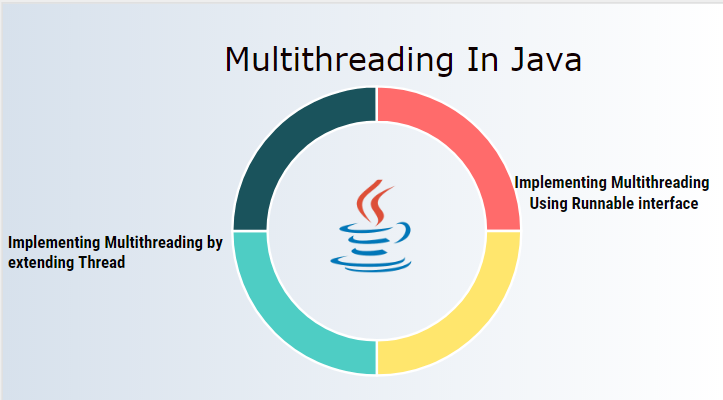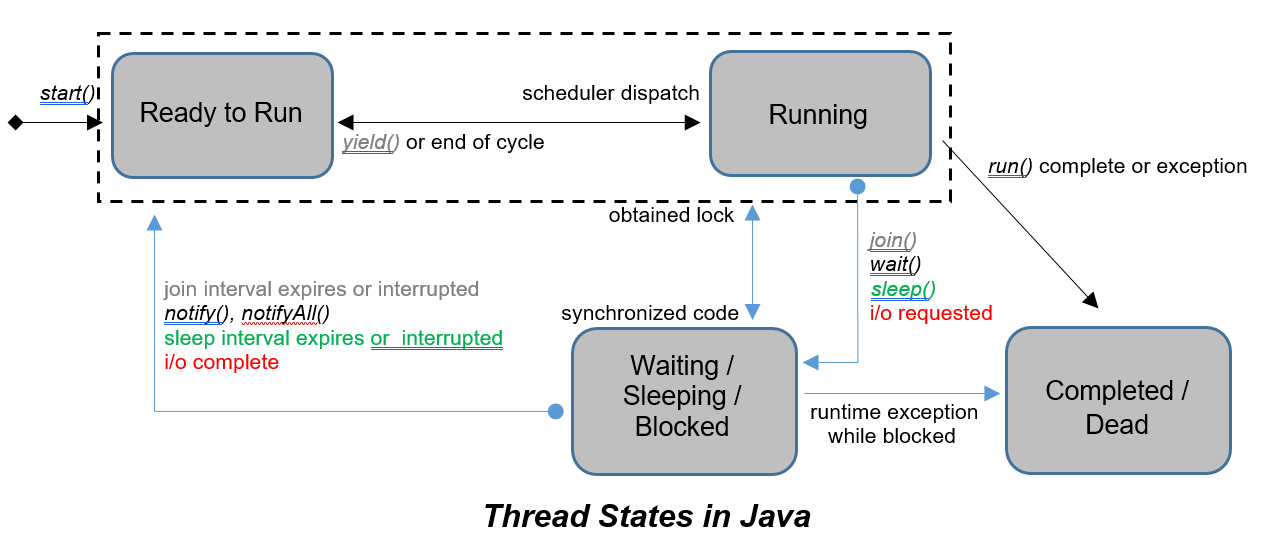Explain Different Ways of Implementation of Multithreading in Java
In this you have to just extend the Thread classAfter extending simply make the object of your class. Multithreading is the process of executing multiple thread simultaneously.

Multithreaded Servers In Java Geeksforgeeks
Explain multithreading in Java.

. The second thing is to call the start method on Thread class object to create a thread of execution in Java Stack area. The Thread class extends to creates the multiple thread in java. Implementing the Runnable Interface.
Daemon threads are mainly used in the background and are used for tasks like cleaning the application etc. Create thread in java using Runnable. Mutual Exclusive helps keep threads from interfering with one another while sharing data.
User thread is created when the application first starts. We have used few of these methods in the example below. All synchronized blocks synchronize on the same object can only have one thread executing inside them at a time.
By using new perator like Thread t1 new. In Java one can get the current state of a thread using the ThreadgetState method. Causes the currently executing thread to sleep temporarily cease execution for the.
There are two ways to create multiple thread in java. Public void run. A synchronized block in Java is synchronized on some object.
Public class Main implements Runnable public static void mainString args Main obj new Main. Thread creation by extending the Thread class. By extending Thread class.
Java program that creates three threads. We create a class that extends the javalangThread class. This class overrides the run method available in the Thread class.
Cooperation Inter-thread communication in java Mutual Exclusive. The first thread displays Good Morning for every one second the second thread displays Hello for every two seconds and third thread displays Welcome for every three seconds. In this tutorial we saw multithreaded applications in Java and how to use single and multi thread in Java.
You should extend Thread class only when you need to override use or modify some of the code of Thread class. There is exactly one way to create a new thread in Java and that is to instantiate javalangThread to actually run that thread you also need to call start. Synchronization is a process of handling resource accessibility by multiple thread requests.
Java offers implementation of multi-threading by two ways. 2 By implementing Runnable interface. Write a Java program to create multiple thread in Java.
Java Thread Class methods usage and examples. Multithreading is the phenomenon of executing more than a thread in the system where the execution of these threads can be of two different types such as Concurrent and Parallel multithread executions. By Using Synchronized Method.
Myclass t new myclass. Multithreading Program in Java. Thread thread new Threadobj.
By implementing the Runnable interface. Class myclass extends Thread. A ThreadFactory implementation will instantiate Thread objects at some point.
Java accomplishes multithreading through its javalangThread class. Is used to perform action for a thread. And do this only when you are sure that your class wont need to extend other class.
The easiest way to create a thread is to create a. Creating a thread in Java. There are two ways to create a thread in Java.
Public void run SystemoutprintlnThis code is. 37 rows Multitasking is a process of executing multiple tasks simultaneously. The main purpose of synchronization is to avoid thread interference.
At times when more than one thread try to access a shared resource we need to ensure that resource will be used by only one thread at a time. By Using Static Synchronization. There are two ways creating of a thread by Implementing Runnable interfaceExtending Thread classwhen using runnable interface its have facility to extends another classes so we can acheive multiple inheritanceby using Thred class we have so many methods like notify resume suspend notifyall wait methods.
Java threads are of two types. Implementation of Thread States. The javalangThreadState class of Java provides the constants ENUM to represent the state of a thread.
Everything else that creates threads in Java code falls back to this one way behind the cover eg. 1 By extending Thread class. Synchronized blocks in Java are marked with the synchronized keyword.
A thread begins its life inside run method. Public void start. A Thread can be defined as a chunk or unit of a process that can be identified as either a user-level thread or a Kernel-level thread.
Lets takes an example to understand how we can create start and run the thread using the runnable interface. By Using Synchronized Block. Then we can create as many user and daemon thread.
Java is a multi-threaded programming language which means we can develop multi-threaded program using Java. Various stages of life cycle of the thread are New. SystemoutprintlnThis code is outside of the thread.
Java provides a way of creating threads and synchronizing their tasks using synchronized blocks. By Implementing Runnable interface. To become efficient in writing the multithreaded code you must know about the constructors and the methods of thread class before starting to write multithreading programs in Java.
Systemoutprintln name thread exiting. These are the two different ways to create thread in java. By extending the Thread class.
To implement multithreading Java defines two ways by which a thread can be created. Starts the execution of the threadJVM calls the run method on the thread. The runnable interface provides us both the run method and the start method.
In Java we can also create a thread by implementing the runnable interface. It can be achieved by using the following three ways. In multithreading users are not blocked as threads are independent and can perform multiple operations at time.
Concept of Lock in Java. Implementing the Runnable Interface. A multi-threaded program contains two or more parts that can run concurrently and each part can handle a different task at the same time making optimal use of the available resources specially when your computer has multiple CPUs.
First is by using runnable interface and second is by using Thread class. Before we begin with the programscode of creating threads lets have a look at these methods of Thread class. There are mainly two way to do multithreading.
Public void sleep long miliseconds. In these two ways first step we need to override run method and place corresponding logic that should be executed concurrently. There are two different ways.
1 Using Thread class. The following diagram shows the different states involved in the life cycle of a thread.

What Is Multithreading In Java Implementation Uses Career Growth

What Is Multithreading In Java Implementation Uses Career Growth

No comments for "Explain Different Ways of Implementation of Multithreading in Java"
Post a Comment